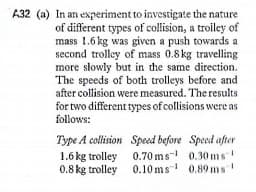A proton of mass 1.6 x 10-" kg travelling with a velocity of 3 x 10°ms' collides with a nucleus of an oxygen atom of mass 2.56 x 10- kg (which may be assumed to be at rest initially) and rebounds in a direction at 90 to its incident path. Calculate the velccity and direction of motion of the recoil oxygen nucleus, assuming the collision is elastic znd negiecting the relativistic increase of mass. (0 & C*]
A proton of mass 1.6 x 10-" kg travelling with a velocity of 3 x 10°ms' collides with a nucleus of an oxygen atom of mass 2.56 x 10- kg (which may be assumed to be at rest initially) and rebounds in a direction at 90 to its incident path. Calculate the velccity and direction of motion of the recoil oxygen nucleus, assuming the collision is elastic znd negiecting the relativistic increase of mass. (0 & C*]
College Physics
10th Edition
ISBN:9781285737027
Author:Raymond A. Serway, Chris Vuille
Publisher:Raymond A. Serway, Chris Vuille
Chapter6: Momentum And Collisions
Section: Chapter Questions
Problem 8WUE: A car of mass 750 kg traveling at a velocity of 27 m/s in the positive x-direction crashes into the...
Related questions
Concept explainers
Question
100%
Show all working explaining detailly each step.
![A proton of mass 1.6 x 10-27 kg travelling
with a velocity of 3 x 10° ms' collides with a
nucleus of an oxygen atom of mass
2.56 x 10-20 kg (which may be assumed to
be at rest initially) and rebounds in a direction
at 90 to its incident path. Calculate the
velccity and direction of motion of the recoil
oxygen nucleus,. assuming the collision is
elastic end negiecting the relativistic increase
of mass.
[0 & C*]](/v2/_next/image?url=https%3A%2F%2Fcontent.bartleby.com%2Fqna-images%2Fquestion%2F5a6d9c67-6f13-49d2-ac4d-2d996f90a88b%2F5b23f61c-c0f1-4687-8e40-32620001da10%2F9mf0qsi_processed.jpeg&w=3840&q=75)
Transcribed Image Text:A proton of mass 1.6 x 10-27 kg travelling
with a velocity of 3 x 10° ms' collides with a
nucleus of an oxygen atom of mass
2.56 x 10-20 kg (which may be assumed to
be at rest initially) and rebounds in a direction
at 90 to its incident path. Calculate the
velccity and direction of motion of the recoil
oxygen nucleus,. assuming the collision is
elastic end negiecting the relativistic increase
of mass.
[0 & C*]

Transcribed Image Text:A32 (a) In an experiment to investigate the nature
of different types of collision, a troiley of
mass 1.6 kg was given a push towards a
second trolley of mass 0.8 kg travelling
more slowly but in the same direction.
The speeds of both trolleys before and
after collision were measured. The results
for two different types of collisions were as
follows:
Type A collision Speed before Speed after
1.6 kg trolley 0.70 ms 0.30 ms
0.8 kg trolley 0.10ms 0.89 ms
Expert Solution
This question has been solved!
Explore an expertly crafted, step-by-step solution for a thorough understanding of key concepts.
Step by step
Solved in 3 steps with 3 images

Knowledge Booster
Learn more about
Need a deep-dive on the concept behind this application? Look no further. Learn more about this topic, physics and related others by exploring similar questions and additional content below.Recommended textbooks for you

College Physics
Physics
ISBN:
9781285737027
Author:
Raymond A. Serway, Chris Vuille
Publisher:
Cengage Learning

University Physics Volume 1
Physics
ISBN:
9781938168277
Author:
William Moebs, Samuel J. Ling, Jeff Sanny
Publisher:
OpenStax - Rice University

College Physics
Physics
ISBN:
9781305952300
Author:
Raymond A. Serway, Chris Vuille
Publisher:
Cengage Learning

College Physics
Physics
ISBN:
9781285737027
Author:
Raymond A. Serway, Chris Vuille
Publisher:
Cengage Learning

University Physics Volume 1
Physics
ISBN:
9781938168277
Author:
William Moebs, Samuel J. Ling, Jeff Sanny
Publisher:
OpenStax - Rice University

College Physics
Physics
ISBN:
9781305952300
Author:
Raymond A. Serway, Chris Vuille
Publisher:
Cengage Learning

Principles of Physics: A Calculus-Based Text
Physics
ISBN:
9781133104261
Author:
Raymond A. Serway, John W. Jewett
Publisher:
Cengage Learning

Physics for Scientists and Engineers: Foundations…
Physics
ISBN:
9781133939146
Author:
Katz, Debora M.
Publisher:
Cengage Learning

College Physics
Physics
ISBN:
9781938168000
Author:
Paul Peter Urone, Roger Hinrichs
Publisher:
OpenStax College